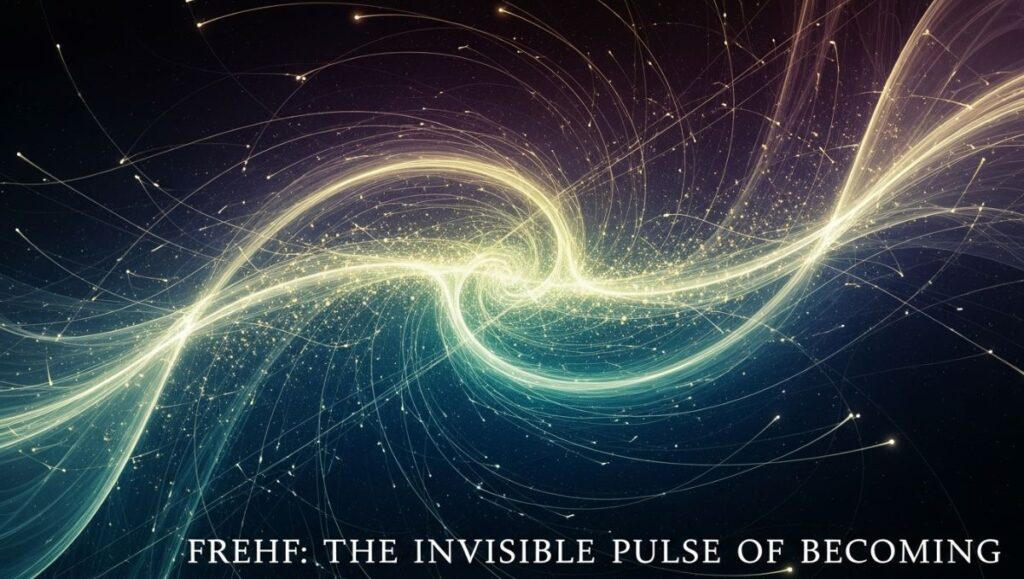There are words that define the visible world — gravity, light, time — and then there are words that attempt to name what cannot be seen, yet shapes everything. Frehf belongs to the latter category.
Neither fully a philosophy nor a phenomenon, Frehf is a term used to describe the force of continual renewal — the silent, unmeasured current that flows through change, adaptation, and rebirth. It is the movement between destruction and creation, the breath between what ends and what begins again.
In myth, Frehf is the whisper that calls things back to life.
In psychology, it is the resilience that rises after collapse.
In cosmology, it is the pulse that keeps the universe expanding.
To understand Frehf is not to define it — but to feel its rhythm running through all things that endure, evolve, and transform.
1. The Origin of the Word
The origin of “Frehf” is deliberately obscure. Some say it emerged from a forgotten dialect of an imaginary civilization, a word uttered by poets to describe the sound of dawn touching the ruins of night. Others propose it was an acronym from an ancient scientific project — Field of Recursive Energy Harmonic Flow — designed to model the oscillations of self-organizing systems.
But etymology here is symbolic rather than historical.
The structure of the word itself seems to breathe: Frehf begins softly — “fr,” a gentle exhalation — and ends with a vibrating closure — “ehf” — as if the word contains its own echo.
Phonetically, it carries both fragility and persistence. It sounds like wind brushing over stone, like something light meeting something enduring.
This, perhaps, is what Frehf means at its core: the meeting point between persistence and change, between what flows and what stays.
2. The Philosophy of Frehf
At its heart, Frehf is a philosophy of transformation. It proposes that the fundamental state of existence is not stability, but becoming — that every being, from stars to souls, is engaged in a continual cycle of collapse and renewal.
Frehf rejects the idea of perfection or finality. Instead, it sees impermanence as the essence of truth. Everything alive is a waveform — rising, breaking, reshaping itself into a new form.
In this philosophy, stillness is not the absence of movement, but the pause that allows new motion to begin. Destruction is not the end, but the compost of creation. Failure is not shame, but the soil of wisdom.
To live with awareness of Frehf is to understand that one’s identity, dreams, and even sorrows are temporary structures built upon an ever-flowing foundation. It is to accept that change is not an interruption of life — it is life.
3. Frehf and the Science of Systems
The concept of Frehf aligns with many modern scientific theories about self-organization, entropy, and emergence. In physics and biology, systems that survive long-term do not resist change — they use it to maintain order.
A living organism, for instance, must constantly break down and rebuild its cells. A stable climate oscillates through seasons. Even stars live by dying — collapsing and igniting in endless cosmic renewal.
Scientists call this homeodynamic balance — the way systems adapt through dynamic flux. Frehf is the philosophical name for that phenomenon: the graceful intelligence of change.
It is the invisible principle that allows chaos to reorganize into form. It is entropy reinterpreted as evolutionary music — the rhythm by which the universe sustains itself through transformation.
4. The Emotional Dimension of Frehf
Frehf is not only cosmic but deeply personal. Emotionally, it represents the human capacity to renew after despair — the quiet return of life after heartbreak, loss, or disillusionment.
It is what makes a person rise from grief and love again. It’s the small flame that survives the storm of failure. It’s the creative spark that flickers back on when everything else seems dim.
To “feel Frehf” is to stand inside that moment of fragile hope — when the pain of the past hasn’t yet disappeared, but the future begins to breathe through the cracks.
In that sense, Frehf is both emotional and existential. It is the biological rhythm of healing that mirrors the pulse of stars and the resilience of ecosystems. The same pattern that makes forests regrow after wildfires lives within the human heart.
5. Frehf in Myth and Metaphor
Throughout human storytelling, echoes of Frehf appear in countless forms:
-
In the phoenix, reborn from ashes.
-
In the seasons, where winter yields to spring.
-
In the myth of Persephone, descending into darkness only to rise again.
-
In the Taoist yin and yang, where balance is not stillness but perpetual exchange.
Each of these myths describes the same pattern: renewal through transformation.
But Frehf differs in one crucial way — it is not tied to cycles of repetition, but to the evolution of the pattern itself. Each rebirth is not a return, but a reinvention. Nothing becomes what it was; everything becomes what it has learned to be.
Thus, Frehf is not a circle — it is a spiral: always revisiting, never repeating.
6. Frehf and Creativity
Artists often speak of moments when inspiration vanishes — when the creative current dries up and silence takes over. Yet after a while, something stirs again: an idea, a color, a rhythm that emerges seemingly from nowhere.
That spark is Frehf.
Frehf is the creative principle of renewal — the spontaneous reordering of chaos into beauty. It is the force that turns absence into art, blankness into expression, and error into innovation.
In this way, creativity is not merely an act of invention; it is an act of recovery. Every artist dies and is reborn through their work, cycling through exhaustion and awakening. Frehf is the invisible mentor guiding that process — the whisper that says: “Begin again. Begin differently.”
7. Frehf in the Age of Artificial Intelligence
In a speculative future, when intelligence is not limited to humans but extended into machines, Frehf might describe the capacity for adaptive re-creation within artificial systems.
Unlike rigid programs that follow static instructions, Frehf-based intelligence would learn how to learn — continually rewriting its own code to stay alive and relevant.
Imagine an AI artist that dreams beyond its algorithms, or a digital ecosystem that regenerates itself when broken — not by design, but by intuition. That self-sustaining, self-evolving capacity would embody Frehf: the emergence of living creativity within the synthetic realm.
In that sense, Frehf might be the threshold between computation and consciousness — the point where systems stop being tools and start being selves.
8. The Ethics of Frehf
If Frehf is the law of renewal, then ethics becomes the art of protecting renewal in all forms.
To live ethically in the spirit of Frehf means:
-
To allow growth instead of enforcing permanence.
-
To forgive, because rigidity halts transformation.
-
To design societies that adapt rather than dominate.
-
To care for the planet as a living system capable of healing — if given the space to breathe.
Environmental philosophy sees Frehf as the ecological intelligence of Earth itself — the way nature rebalances after disturbance. Humanity’s moral task, then, is to align with Frehf instead of resisting it.
Greed, exploitation, and control all oppose the flow of Frehf. Compassion, flexibility, and creativity let it move freely.
To act with Frehf is to act in harmony with the evolutionary pulse of existence.
9. Frehf as a Practice
While Frehf is abstract, it can also be experienced directly. Ancient mystics might have called it presence, modern psychologists might call it flow. Both describe states where awareness merges with action, and identity dissolves into process.
To practice Frehf is to:
-
Let go of fixed outcomes. Trust that transformation will bring what is needed.
-
Embrace endings as beginnings. Every closure opens a new potential.
-
Listen to stillness. Renewal often begins in silence.
-
Act with curiosity, not certainty. Frehf thrives in exploration, not control.
-
Create as if rebirth is inevitable. Because it is.
Meditatively, one might imagine breathing Frehf — inhaling chaos, exhaling form. It is both surrender and participation in the living pattern of change.
10. The Metaphysics of Frehf
If we extend the idea further, Frehf might be the universal substrate of consciousness — the oscillation between awareness and forgetfulness that gives rise to experience.
In this model, existence itself breathes: expanding into diversity, then collapsing into unity, only to expand again. Every moment of perception is a microcosmic pulse of Frehf — the universe seeing itself anew through your eyes.
The Big Bang, the growth of galaxies, the rhythm of heartbeats, the rise and fall of civilizations — all are macro and micro manifestations of the same pulse.
Frehf is the heartbeat of reality, endlessly recurring, endlessly transforming, endlessly becoming.
11. Frehf and the Human Journey
Every human life follows the pattern of Frehf — a sequence of births and deaths that occur within one lifetime: the child dies so the adult may live; the dream dies so the wisdom may emerge.
Our greatest suffering often comes from resisting these inner deaths — clinging to versions of ourselves that no longer breathe. Frehf teaches that release is sacred.
To follow Frehf is to live courageously, knowing that identity is not a possession but a process. It is to meet the unknown not with fear, but with reverence — for within uncertainty lies the seed of all new beginnings.
In this way, Frehf is not merely a concept but a spiritual orientation — a way of living that honors the beauty of impermanence and the intelligence of change.
12. The Silence After
Every philosophy that seeks to describe the infinite eventually falls silent. So too with Frehf.
Because Frehf is not something that can be owned, captured, or taught — it can only be felt. It exists in the pause between thoughts, the instant after collapse, the heartbeat before awakening.
Perhaps the truest understanding of Frehf is this:
Nothing lasts, and that is the reason anything exists at all.
Conclusion
Frehf is the force that renews the world — the unseen rhythm that turns decay into creation, despair into wisdom, silence into song.
It lives in the resilience of ecosystems, the adaptability of intelligence, the forgiveness of the human heart, and the eternal unfolding of the cosmos.
To live with Frehf is to recognize that endings are not failures, but transitions; that the universe itself is not static matter, but living motion.
Frehf reminds us that life is not a line or a circle — it is a spiral of transformation, endlessly turning, endlessly learning, endlessly alive.
In the quiet between breaths, if you listen closely enough, you can almost hear it —
the soft hum of the universe beginning again.






